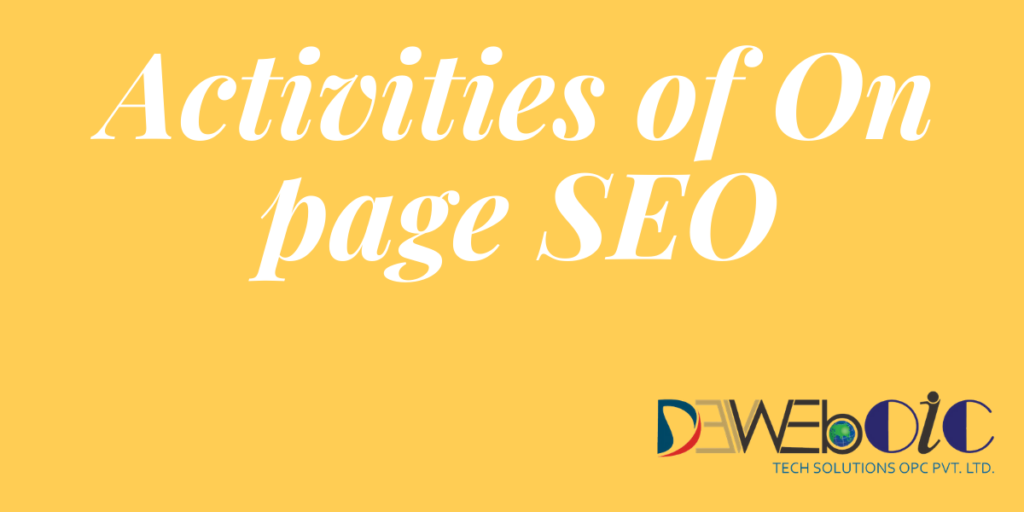What Is On-Page SEO?
Activities of On page SEO 2022 (known as on-site SEO) refers to the exercise of optimizing pages to enhance a website’s search engine rankings and acquire organic traffic. As well as publishing relevant, quality content, on-page SEO involves optimizing your headlines, HTML tags (title, meta, and header), and pictures. It also means making sure your site has a high level of expertise, authoritativeness, and trustworthiness.
In this blog, you’ll learn six major activities of On Page SEO 2022, which you can use to improve your website’s on-page SEO, including:
Integrate relevant keywords into your pages
Optimize your title tag and Meta description
Use internal links on your pages
Add responsive design to your website
#1: Integrate relevant keywords into your pages
If you want to rank in the Search Engine Results Page (SERP), you need to integrate relevant keywords into your website. To discover the relevant keywords for your website, begin by conducting keyword research. You can use Google search planner and Ubersuggest which will help you find relevant terms for your pages.
At the point when you when you manage keyword research, focus on long-tail keywords. Long-tail keywords contain three or more words, Best SEO consultant in Delhi.
Long-tail keywords are greatest for your site as they help you drive more qualified traffic to your pages. When somebody searches a particular term, the search intent is more precise, and you know what they want to find. For example, if somebody searches “SEO,” it’s hard to know the intent behind that search. The keyword is too small for you and your website to recognize the search purpose behind it clearly.
Furthermore, a keyword like “SEO freelancer in Delhi” is clearer. You know someone’s looking for a SEO freelancer. Once you have your long-tail keywords discovered, you’ll integrate them into your site to get more qualified results.
#2: Optimize your title tag and Meta description
It appears as a blue line of text on the Google search results page (SERP) that individuals can click on to navigate to the page on your site. Clients and Google search engines utilize this to check if your listing is relevant to their search query.

Your Meta description is the small message that appears below the title tag. This tag give your audience with a summary of your page.

To have a click-worthy title Tag
- Stay within the 60-character limit
- Use long-tail keyword towards the front of your tag
- Use power words (i.e., Best, Top)
To have a compelling Meta description
- Stay within the 120-155-character limit.
- Summarize what individuals can discover on your page
- Use your main keyword in your description
#3: Optimize images
Next on our rundown of on-page SEO activities is improving pictures. Pictures are an important segment to giving a positive user experience on your site. They help enhance your pages and engaging for your audience.
Follow these two best practices to optimize your images:
Optimize your image file sizes: If your image file sizes are too big, they slow down your site, which negatively impacts your SEO. To stop this from happening, you can use an image compression tool like Image compressor to compress image file sizes.

Use image alt tags: As Google unable to read images, you’d need to add on image alt tags to help out search engines “read” them easily
#4: Use internal links on your page
These links are links on your page to other pages on your website. Internal links are a fundamental part of SEO for two reasons:
- These are the links that help search engines to discover new pages on your website and get them to index them in the Search Engine Results Page (SERP).
- These links basically help keep users on your website longer to reduce the bounce rate.
When you use internal links on your page, you want to ensure you create relevant anchor text for those links.
#5: Improve site load time
One of the most crucial on-page SEO tasks involves enhancing website loading time. Users look for your website to load in within 3 seconds. In case your website loads too slowly, your audience will bounce back to the search engine results and visit another site instead.
When people bounce from your site, it informs search engines that your website is not relevant to the search results. Google Search engines won’t rank your website as highly.
To stop this from happening in the future, you can use a tool like Google Page Speed Insights to help you see your website’s current load time and the ways to improve it.
#6: Add responsive design to your website
Final on our list of on-page SEO techniques are integrating responsive design. People will access your website from mobile devices, like smartphones, tablets, and computers. If your website isn’t optimized for these devices, you risk delivering a poor mobile experience so make sure your website is responsive for all the devices available in the market.

